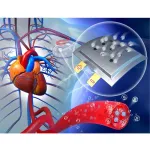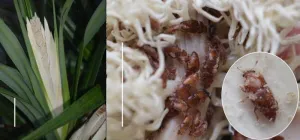Implantable batteries can run on the body’s own oxygen
2024-03-27
(Press-News.org)
From pacemakers to neurostimulators, implantable medical devices rely on batteries to keep the heart on beat and dampen pain. But batteries eventually run low and require invasive surgeries to replace. To address these challenges, researchers in China devised an implantable battery that runs on oxygen in the body. The study, published March 27 in the journal Chem, shows in rats that the proof-of-concept design can deliver stable power and is compatible with the biological system.
“When you think about it, oxygen is the source of our life,” says corresponding author Xizheng Liu, who specializes in energy materials and devices at Tianjin University of Technology. “If we can leverage the continuous supply of oxygen in the body, battery life won’t be limited by the finite materials within conventional batteries.”
To build a safe and efficient battery, the researchers made its electrodes out of a sodium-based alloy and nanoporous gold, a material with pores thousands of times smaller than a hair’s width. Gold has been known for its compatibility with living systems, and sodium is an essential and ubiquitous element in the human body. The electrodes undergo chemical reactions with oxygen in the body to produce electricity. To protect the battery, the researchers encased it within a porous polymer film that is soft and flexible.
The researchers then implanted the battery under the skin on the backs of rats and measured its electricity output. Two weeks later, they found that the battery can produce stable voltages between 1.3 V and 1.4 V, with a maximum power density of 2.6 µW/cm2. Although the output is insufficient to power medical devices, the design shows that harnessing oxygen in the body for energy is possible.
The team also evaluated inflammatory reactions, metabolic changes, and tissue regeneration around the battery. The rats showed no apparent inflammation. Byproducts from the battery’s chemical reactions, including sodium ions, hydroxide ions, and low levels of hydrogen peroxide, were easily metabolized by the body and did not affect the kidneys and liver. The rats healed well after implantation, with the hair on their back completely regrown after four weeks. To the researchers’ surprise, blood vessels also regenerated around the battery.
“We were puzzled by the unstable electricity output right after implantation,” says Liu. “It turned out we had to give the wound time to heal, for blood vessels to regenerate around the battery and supply oxygen, before the battery could provide stable electricity. This is a surprising and interesting finding because it means that the battery can help monitor wound healing.”
Next, the team plans to up the battery’s energy delivery by exploring more efficient materials for the electrodes and optimizing the battery structure and design. Liu also noted that the battery is easy to scale up in production and choosing cost-effective materials can further lower the price. The team’s battery may also find other purposes beyond powering medical devices.
“Because tumor cells are sensitive to oxygen levels, implanting this oxygen-consuming battery around it may help starve cancers. It’s also possible to convert the battery energy to heat to kill cancer cells,” says Liu. “From a new energy source to potential biotherapies, the prospects for this battery are exciting.”
###
This work was financially supported by the National Key Research and Development Program of China, the National Science Fund for Distinguished Young Scholars, and the National Natural Science Foundation of China.
Chem, Lv et al. “Implantable and Bio-compatible Na-O2 battery” https://cell.com/chem/fulltext/S2451-9294(24)00074-3
Chem (@Chem_CP) is the first physical science journal published by Cell Press. A sister journal to Cell, Chem, which is published monthly, provides a home for seminal and insightful research and showcases how fundamental studies in chemistry and its sub-disciplines may help in finding potential solutions to the global challenges of tomorrow. Visit https://www.cell.com/chem. To receive Cell Press media alerts, contact press@cell.com.
END
[Attachments] See images for this press release:


ELSE PRESS RELEASES FROM THIS DATE:
2024-03-27
Researchers Toru Miyamoto, Ko Mochizuki, and Atsushi Kawakita of the University of Tokyo have discovered the first species pollinated by sap beetles in the genus Pandanus, a group of palm-like plants native to the tropics and subtropics of Africa and Eurasia. The discovery overturned the long-held belief that these plants were pollinated by wind. The researchers also found that fragrant screw pines’ male and female flowers produced heat at night stably, making them the first such species in the family Pandanaceae. The findings were published in ...
2024-03-27
A new Kaiser Permanente study found that a health coaching intervention successfully reduced sitting time for a group of older adults by just over 30 minutes a day. Study participants also showed meaningful improvements in blood pressure, comparable to the effect of other interventions focused on physical activity.
The study was published March 27 in JAMA Network Open and included 283 Kaiser Permanente Washington members aged 60-89.
Older adults typically sit for between 65 and 80 percent of the hours that they are awake, and strong evidence shows that ...
2024-03-27
About The Study: Individuals at high genetic risk of obesity needed higher daily step counts to reduce the risk of obesity than those at moderate or low genetic risk in this study of 3,124 adults. Population-based recommendations may underestimate physical activity needed to prevent obesity among those at high genetic risk.
Authors: Evan L. Brittain, M.D., M.Sc., and Douglas M. Ruderfer, Ph.D., of the Vanderbilt University Medical Center in Nashville, are the corresponding authors.
To access the embargoed study: Visit our For The Media website at this link https://media.jamanetwork.com/
(doi:10.1001/jamanetworkopen.2024.3821)
Editor’s Note: Please ...
2024-03-27
Using patient data from six major U.S. cancer centers, Brigham researchers and collaborators developed a risk prediction model for moderate-to-severe kidney injury after receiving the chemotherapy drug cisplatin in the largest, first generalizable study of its kind
Cisplatin is a highly effective chemotherapy that has been used to treat cancer for decades, but it can cause kidney injury that can potentially lead to the discontinuation of life-saving cancer treatments. Investigators from Brigham and Women’s Hospital (BWH), a founding member of the Mass General Brigham healthcare system, with researchers from the Dana-Farber Cancer Institute and other institutions, ...
2024-03-27
About The Study: High prices limit access to newer diabetes medicines in many countries. The findings of this study suggest that robust generic and biosimilar competition could reduce prices to more affordable levels and enable expansion of diabetes treatment globally.
Authors: Melissa J. Barber, Ph.D., of the Yale Collaboration for Regulatory Rigor, Integrity, and Transparency in New Haven, Connecticut, is the corresponding author.
To access the embargoed study: Visit our For The Media website at this link https://media.jamanetwork.com/
(doi:10.1001/jamanetworkopen.2024.3474)
Editor’s ...
2024-03-27
Persons with a higher genetic risk of obesity need to work out harder than those of moderate or low genetic risk to avoid becoming obese, according to a Vanderbilt University Medical Center (VUMC) paper published in JAMA Network Open.
Study authors used activity, clinical and genetic data from the National Institutes of Health’s All of Us Research Program to explore the association of genetic risk of higher body mass index and the level of physical activity needed to reduce incident obesity.
“Physical activity guidelines do not ...
2024-03-27
Evanston, IL – The International Society for Stem Cell Research (ISSCR) is pleased to announce the results of its 2024 election. Lorenz Studer, MD, founding director of the Center for Stem Cell Biology and member of the Developmental Biology Program, Memorial Sloan Kettering Cancer Center, USA, will become the next Vice President. All terms of office for the new leaders will begin on 1 July 2024.
The following three members were newly elected to the ISSCR Board of Directors for a three-year term:
Jacqueline Barry, PhD, ...
2024-03-27
McGill researchers have discovered a safer and more efficient technique for testing new drugs while they are in development.
“Because this approach is so much more streamlined, it could help accelerate this step in the drug development process and make it less dangerous, since probing the distribution and fate of a drug in the body is required for any pharmaceutical candidate to be approved,” says Bruce A. Arndtsen, a James McGill Professor who teaches in the Department of Chemistry at McGill and is the senior author on the paper describing the new process, published recently in Nature Chemistry.
“This research replaces what can be a days’ long, dangerous and ...
2024-03-27
FRANKFURT. In 2022, scientists of the EHT unveiled the first image of Sgr A* – which is approximately 27,000 light-years away from Earth – revealing that the Milky Way’s supermassive black hole looks remarkably similar to M87’s, even though it is more than a thousand times smaller and less massive. This made scientists wonder whether the two shared common traits outside of their looks. To find out, the team decided to study Sgr A* in polarized light. Previous studies of light around M87* had shown that the magnetic fields around the gigantic black hole allowed it to launch powerful jets of material back into the surrounding environment. ...
2024-03-27
Imagine being middle aged and starting to feel that you are off balance a lot and that you are having a hard time coordinating your movements. Those are among the symptoms of Spinocerebellar ataxia type 6, known as SCA6, a rare neurodegenerative disease which typically appears in adulthood and worsens over time. Over time, other problems such as slurred speech and difficulty seeing or seeing double, may also appear. It is estimated that fewer than 5,000 people in the US have the condition, which is the result of genetic mutations in the cerebellum.
The disease currently has no cure. But this may change, thanks to a new discovery made by McGill researchers.
In ...
LAST 30 PRESS RELEASES:
[Press-News.org] Implantable batteries can run on the body’s own oxygen





